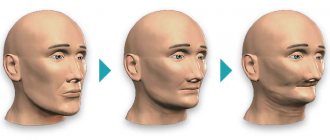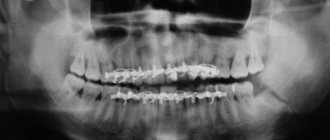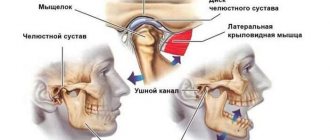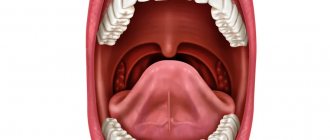Structure
The formation of the mandibular region is the result of the evolution of the human body. In the process of development, the entire structure became mobile and autonomous, gaining the ability to move freely and perform the basic functions necessary for a person. The temporal joint is localized in the fossa, connecting to the bony part.
When a subluxation occurs, the head of the joint partially comes out of the fossa, succumbing to the influence of external factors. As a rule, this phenomenon becomes a consequence of a general weakening of the ligaments or disturbances in the articular cavity. If you have the proper skills and practical experience, you can restore the original position of the jaw yourself, but the systematic occurrence of such a problem is the basis for complex treatment.
Comments
My brother somehow had a dislocated jaw. He said it hurt terribly! But can there be relapses?
Andrey (12/28/2020 at 01:29 pm) Reply to comment
- Dear Andrey! A relapse, and more than one, is possible if a person suffers from joint diseases and other pathologies (for example, malocclusion), which constantly lead to overload and improper functioning of the temporomandibular joint. And, of course, a new dislocation is possible if you neglect the rules of personal safety, if you get into an accident or other traumatic situations.
Editorial staff of the portal UltraSmile.ru (12/30/2020 at 09:12) Reply to comment
I constantly feel that my jaw seems to be overstrained; sometimes there are clicks on one side. I contacted a therapist. The doctor did not take an x-ray, but felt and determined a slight inflammation. He only prescribed ibuprofen, and said everything else would go away on its own. But I don’t understand how the medicine will help relieve tension in the jaw?
Katya (16.01.2021 at 14:22) Reply to comment
- Ibuprofen will relieve the inflammatory process, but the tension in the jaw will remain, as it is most likely associated with TMNS dysfunction. You may need to undergo a dental examination by an orthodontist and orthopedist. The problem may be associated with bite pathologies, incorrectly installed orthopedic structures, or the need for their installation.
Editorial staff of the portal UltraSmile.ru (01/19/2021 at 09:24) Reply to comment
Write your comment Cancel reply
Causes and classification
Displacement of the lower jaw is the result of the application of an external force that exceeds in intensity the force of natural fixation. For each person, such a threshold is individual - some patients may suffer from minor force, while others are able to endure strong mechanical impact without consequences.
The main factors determining the tightness of the fit are ligament tension and bone attraction. The weakening of these connections can provoke the occurrence of subluxation, both one-time and in a chronic form. The reasons that negatively affect the condition of the jaw region include:
- Advanced stages of rheumatism;
- Developing arthritis or osteomyelitis;
- The occurrence of cramps and muscle spasms;
- Consequences of encephalitis;
- Epileptic seizures.
They also note the existence of traumatic factors, the occurrence of which can cause subluxation:
- Mechanical injuries - impacts, collisions;
- Excessive opening of the mouth;
- Having bad habits;
- Congenital abnormalities that affect the formation of the articular fossa.
The classification used in dentistry differentiates pathology according to the following criteria:
- Based on the position of the articular head - anterior, posterior and lateral subluxation;
- According to the specificity of the displacement - one-sided and two-sided form;
- Depending on the severity - for simple and complex cases.
The choice of technique, as well as the timing of treatment, depend on the original source of the problem. It is easiest to cure the pathology in the early stages, so at the first symptoms of subluxation it is recommended to consult a doctor and undergo an examination.
Causes of jaw dislocation
Dislocation of the lower jaw can occur as a result of screaming, strong yawning, while eating or vomiting, that is, in those moments when the mouth opens sharply and widely (trying to bite off too large a piece of food can also cause jaw dislocation.). Bad habits of opening bottles or packages with your teeth can also cause harm, excessively straining your jaw.
There are frequent cases of its damage as a result of a strong blow. Professional athletes - wrestlers and boxers - face dislocation of the lower jaw. You can cause displacement of the articular head by chewing too hard and tough food, for example, nut shells. To protect your jaw from damage, you should avoid too sudden and rapid movements while yawning and chewing.
Dislocation of the lower jaw can also be non-traumatic. For example, some diseases, including rheumatism, gout, osteomyelitis, poliomyelitis, arthritis or arthrosis, cause relaxation of the ligaments, as a result of which the height of the joint decreases and its shape is deformed.
In women, due to the shallower depth of the articular fossa, it is easier to displace the head of the joint. Accordingly, jaw dislocation occurs much more often in them than in men.
Symptoms and signs
For each form of subluxation, there are characteristic individual signs that indicate the presence of deviations. However, there are a number of universal symptoms observed in all types of pathology:
- The occurrence of pain of varying severity, aggravated when the patient attempts to move the lower jaw;
- Limited mobility of the temporomandibular joint, making it difficult to perform usual actions - eating or speaking;
- Active secretion of saliva associated with a swallowing problem.
In addition, with bilateral dislocations affecting the anterior zone, the following circumstances occur:
- Inability to close the jaws, forcing the patient to keep his mouth open;
- Pain in the skull and swelling of tissue in the ear area;
- Partial or complete dysfunction of the speech apparatus.
The unilateral form of subluxation has similar symptoms, but allows partial closure of the mouth, which significantly alleviates the patient’s problems. In turn, posterior bilateral subluxation is characterized by the opposite symptomatology - the inability to open the jaw, pressing of the lower part into the larynx area.
First aid and treatment
If a subluxation occurs, it is recommended to straighten the jaw using the infiltrative or guide method, after first calming the patient and giving him an anesthetic. The lack of such skills requires contacting a qualified orthodontist, who will not only restore the natural structure of the jaw apparatus, but also advise measures aimed at restoring and preventing recurrences. If the procedure aimed at realigning the joint is carried out in a timely manner, as well as medical recommendations are followed during the rehabilitation period, the prognosis for a complete cure is very favorable.
Group No. 5: acute and old
If the dislocation or subluxation of the jaw is fresh, that is, it occurred quite recently, then symptoms such as pain and malaise appear clearly, and doctors speak of an acute form.
It’s hard to believe, but there are situations when, when injured, the patient is in no hurry to seek professional help. Either first aid was unqualified and the treatment of acute dislocation was carried out incorrectly. In all of these cases we are talking about old dislocations. Only a few correction methods are suitable for their reduction, which are very painful and require long-term rehabilitation.
What type of dislocation a particular person has can only be told by a doctor who will make an accurate diagnosis based on a visual examination and using radiography, which allows one to determine the extent and extent of the problem, as well as to exclude the presence of fractures and cracks in the jaw bone.
The type of dislocation can only be detected on an x-ray
Symptoms
Symptoms of a dislocated jaw are as follows:
- feeling of pain in the chin;
- modification of the standard bite;
- inability to fully open or close the oral cavity;
- excessive salivation;
- speech disorder;
- swelling under the hearing organs;
- characteristic clicks in the moving part.
Bleeding from the mouth or ear, partial loss of vision, paralyzing pain in the neck - indicate symptoms of a pronounced dislocation of the jaw. In this case, the injured person is wrapped in a wet towel, specialists are called or escorted to the nearest emergency room.
Clinical manifestations
Symptoms depend on the type of dislocation. Common manifestations include:
- difficulty closing and opening the mouth;
- protrusion or distortion of the jaw forward;
- sharp pain radiating to the temple;
- profuse drooling;
- inability to pronounce words normally.
Treatment of habitual jaw dislocation should be carried out exclusively by a specialist. The only thing the patient can do is fix the position by bandaging his chin with a scarf. Painkillers and ice will help reduce pain.
On our website Dobrobut.com you can sign up for a consultation with the right specialist and undergo diagnostics if necessary.
Reviews
Regardless of the reason why subluxation of the jaw develops, the situation should under no circumstances be left to chance. The main thing is to contact the clinic in a timely manner.
If you have encountered this anomaly from your own experience, you can leave your comment in the appropriate section, and perhaps this will be extremely useful to someone.
If you find an error, please select a piece of text and press Ctrl+Enter.
Tags: jaw subluxation
Did you like the article? stay tuned
Previous article
What is dangerous about viral stomatitis in children and the subtleties of its treatment
Next article
Technological features of All on 4 implantation
Complications
If the patient promptly sought medical help and strictly followed the recommendations while wearing the splint, then the outcome is favorable. In this case there should be no relapses. But early load on the jaw and the presence of deforming joint diseases can provoke a relapse, and, as a rule, more than one.
Make an appointment with our specialists and find out first-hand the main symptoms of a dislocated lower jaw. Remember that only qualified medical care will help you get rid of the problem for a long time and enjoy all the joys of life.
Related services: Dental implantation Treatment of temporomandibular joint disorders
Treatment
Only a doctor should correct a dislocation. Self-medication will only worsen an already difficult situation.
After examining the patient and receiving the X-ray results, the doctor will reduce the dislocation using one of the following methods, namely:
- Blechman-Gershuny method;
- Popescu method;
- Hippocratic method;
- Holorovich method.
How to set a dislocated jaw using the Hippocratic method. The patient is seated on a chair so that the back of his head rests against the back. The patient's lower jaw is at the level of the doctor's elbow. The surgeon wraps his thumbs with cloth and places them on the patient's molars. The remaining fingers grasp the lower part of the patient's chin. After this, the doctor lifts the chin and moves the jaw down and back. This way the head falls into place. After this, a special fixing splint is applied to the jaw. The patient must wear this bandage for at least 10 days. In addition, doctors recommend abstaining from solid foods during treatment. Porridge, pureed soups, vegetable puree are the basis of the diet. You cannot open your mouth wide, shout or eat in large quantities.
The doctor will tell you whether you can dislocate your jaw when yawning during your consultation.
Diagnostics
In order to make a diagnosis, the doctor conducts an examination according to the following scheme:
- Questioning the patient. Of interest to the specialist are complaints, conditions for the appearance of unpleasant symptoms, duration of the disease, previous treatment and its effectiveness.
- External examination and palpation. The gnathologist examines the patient’s face, paying attention to the area where the TMJ is located. By feeling the joints, you can get an idea of its structure and the state of its tissues.
- Dental examination. Anomalies of occlusion and the degree of their severity are identified.
- X-ray examination. The photographs show the bone formations that form the joint. By their relative position one can determine the presence of dislocations and subluxations, and by the thickness of the joint space one can judge the condition of the cartilaginous disc.











